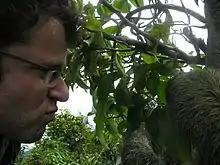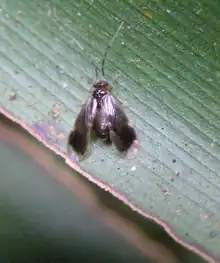Philippe Cuénoud
Philippe Cuénoud (born July 8, 1968) is a Swiss entomologist and botanist living in Onex (near Geneva), who worked on the Psocoptera of Switzerland[1] and Papua New Guinea,[2] as well as on plant phylogeny.[3][4][5][6] He found the only recently known population of Lachesilla rossica near Geneva (the species has been described from southern Russia and may still exist there) and contributed further to the knowledge of the flora and fauna of the canton of Geneva with the first mention of a slender-billed gull[7] (a Mediterranean bird species usually absent form Switzerland) and with the discovery of the first reported population of small-leaved helleborines.[8] He also participated in a multidisciplinary study of the free-living fauna and flora of Basel's Zoo.[9] In a 1999 trip to Brasil with Alain Chautems, he was among the first few people to see the newly rediscovered flower Sinningia araneosa, that had gone missing for more than a century.[10]

Philippe cuénoud | |
|---|---|
 Philippe Cuénoud with a three-toed sloth in Panama, 2006. | |
| Born | 8 July 1968 |
| Nationality | Swiss |
| Alma mater | University of Geneva |
| Scientific career | |
| Fields | Entomology and Botany |
| Thesis | Phylogénie moléculaire, taxonomie et biogéographie du genre Ilex L. (Aquifoliaceae) (1998) |
| Doctoral advisor | Rodolphe Spichiger |
In 2022, he joined Onex's City Council to help better protect a population of autumn lady's-tresses.[11]
Entomology
Cuénoud collected Psocoptera (an insect order related to lice) for the best part of the year 1993 in Papua New Guinea, on the traditional grounds of the Biangai and Biaru people, in the Morobe province, as well as in the Baitabag forest, in the Madang province, and took part in a survey of the bird species of the Kuper mountain range.[12] The rich material obtained allowed him to revise the New Guinean endemic genus Novopsocus (Pseudocaeciliidae) and to describe the two new species Novopsocus magnus and Novopsocus caeciliae,[2] by comparison with specimens of the Australian Museum lent by Courtenay Smithers (previous authors had mistaken males of N. magnus for males of the type species Novopsocus stenopterus, whilst N. caeciliae had never been found before). Cuénoud also had a minor part in the Ibisca project ("Investigating the Biodiversity of Soil and Canopy Arthropods"), an ambitious scientific programme led by Bruno Corbara, Maurice Leponce, Hector Barrios and Yves Basset (with the initial support of Edward O. Wilson), that produced new data on the biodiversity of the San Lorenzo rainforest, on the Caribbean coast of the Panama isthmus (in a paper written by the Ibisca team and featured on the cover of the prestigious scientific journal Science,[13] the total count of arthropod species of the forest was extrapolated to be about 25'000). Cuénoud is possibly the only person this far (as of 2019) to have seen (and photographed) a live specimen of the rare insect species Oronoqua ibisca (Issidae), discovered during the field-sampling phase of the project and known otherwise from dead specimens.[14]

Botany

Cuénoud studied the phylogeny of the genus Ilex (hollies and related species, Aquifoliaceae) with Jean-François Manen, Pierre-André Loizeau and Rodolphe Spichiger,[3] a study that led to the synonymy of the North American genus Nemopanthus with Ilex.[15] He also studied the plant order Caryophyllales (made up of about 30 plant families, many of which are adapted to dry habitats - e.g. cacti - or carnivory: sundews and nepenthes, among others) with Vincent Savolainen and Mark Chase in Kew Gardens, sequencing the matK gene for many of its genera, and analysing the pigments of some of them (some Caryophyllales are known to produce betalains, an almost unique occurrence among Angiosperms).[4][16][17] These results confirmed that Molluginaceae and Phytolaccaceae in their traditional sense are paraphyletic, and contributed to the recognition of the families Barbeuiaceae (containing a single liana species in its own genus, living on the island of Madagascar), Gisekiaceae (made up of the monotypic, African genus Gisekia), Limeaceae (comprising two genera of herbaceous plants from Africa, India and Australia) and Lophiocarpaceae (containing Lophiocarpus and Corbichonia, two genera of herbs from Africa and India).[18]

References
- Cuénoud, Philippe; Lienhard, Charles (1994). "Les Psocoptères du Bassin Genevois". Bulletin Romand d'Entomologie (in French). 12: 7–41.
- Cuénoud, Philippe (2008). "A revision of the New Guinean genus Novopsocus Thornton (Psocoptera, Pseudocaeciliidae) with the description of two new species". Revue Suisse de Zoologie. 115: 331–340. doi:10.5962/bhl.part.80430.
- Cuénoud, P., Del Pero Martinez M.A., Loizeau P.-A., Spichiger, R., Andrews S., Manen J.-F. (2000). Molecular phylogeny and biogeography of the genus Ilex L. (Aquifoliaceae). Annals of Botany, 85: 111-122.
- Cuénoud P., Savolainen V., Chatrou L.W., Powell M., Grayer R.J., Chase M.W. (2002). Molecular phylogenetics of Caryophyllales based on nuclear 18S rDNA and plastid rbcL, atpB, and matK DNA sequences. American Journal of Botany, 89: 132-144.
- Savolainen, V. Cuénoud, P. Spichiger, R., Martinez, M. D. P., Crèvecoeur, M. & Manen, J.-F. (1995). The use of herbarium specimens in DNA phylogenetics: evaluation and improvement. Plant Systematics and Evolution 197: 87-98.
- Manen, J.-F., Cuénoud, P. & Martinez, M. D. P. (1998). Intralineage variation in the pattern of rbcL nucleotide substitution. Plant Systematics and Evolution 211: 103-112.
- Lionel Maumary, Laurent Vallotton, Peter Knaus, Simon Birrer (2007). Les oiseaux de Suisse, Station ornithologique suisse.
- Arx B. von & Cuénoud, P. (1992). Epipactis microphylla (Ehrh.) Sw.: une nouvelle espèce d'orchidée pour le Canton de Genève. Saussurea 23: 15-21.
- Burckhardt, D. , Billen, W., Cuénoud, P., Mühlethaler, R., Thieme T. & Wyniger, D. (2008). Staubläuse, Thripse und Schnabelkerfe. In: Baur, B. Billen, W. & Burckhardt, D. (Eds.) Vielfalt zwischen den Gehegen: wildlebende Tiere und Pflanzen im Zoo Basel. Monographien der Entomologischen Gesellschaft Basel, 3: 275-301
- Chautems, A. (1997). New Gesneriaceae from São Paulo, Brazil. Candollea 52: 159-169.
- https://www.onex.ch/fr/onex-officiel/conseil-municipal/composition/ 7/9/2022
- Cuénoud, P., Hutten, M., & Hoeft, R. (1993). Survey of the Avifauna of Kuper Range, Morobe Province, Papua New Guinea. Proceedings of the Biological Society of New Guinea 1: 143-147.
- Basset, Y., Cizek, L., Cuénoud, P., Didham, R.K., Guilhaumon, F., Missa, O., Novotny, V., Ødegaard, F., Roslin, T., Schmidl, J., Tishechkin, A.K., Winchester, N.N., Roubik,D.W., Aberlenc, H.-P., Bail, J., Barrios, H., Bridle, J.R., Castaño-Meneses, G., Corbara, B., Curletti, G., Duarte da Rocha, W., De Bakker,D., Delabie, J.H.C., Dejean, A., Fagan, L.L., Floren, A., Kitching, R.L., Medianero, E., Miller, S.E., de Oliveira, E.G., Orivel, J., Pollet, M., Rapp, M., Ribeiro, S.P., Roisin, Y., Schmidt, J.B., Sørensen, L., & Leponce, M. (2012). Arthropod diversity in a tropical forest. Science, 338: 1481-1484.
- Vladimir M. Gnezdilov, Jacques Bonfils, Henri-Pierre Aberlenc et Yves Basset (2010). Review of the Neotropical genus Oronoqua Fennah, 1947 (Insecta, Hemiptera, Issidae). Zoosystema, 32: 247-257.
- Powell, M., Savolainen, V., Cuénoud, P., Manen, J. F., & Andrews, S. (2000). The mountain holly (Nemopanthus mucronatus: Aquifoliaceae) revisited with molecular data. Kew Bulletin, 55: 341–347.
- Cuénoud, P. (2003). Introduction to Expanded Caryophyllales. In: The Families and Genera of Vascular Plants, Volume V, (K. Kubitzki & C.Bayer eds.), Springer-Verlag, Berlin-Heidelberg.1-4. Conspectus of Families of Expanded Caryophyllales. Ibid. 5-6.
- Cuénoud, P. (2006). Phylogeny, Evolution, and Diversification of Caryophyllales. In: Plant Genome: Biodiversity and Evolution. Science Publishers, Inc. (USA). 1C : 187-218.
- Angiosperm Phylogeny Group (2009), "An update of the Angiosperm Phylogeny Group classification for the orders and families of flowering plants: APG III", Botanical Journal of the Linnean Society, 161 (2): 105–121, doi:10.1111/j.1095-8339.2009.00996.x, archived from the original on 2017-05-25, retrieved 2010-12-10